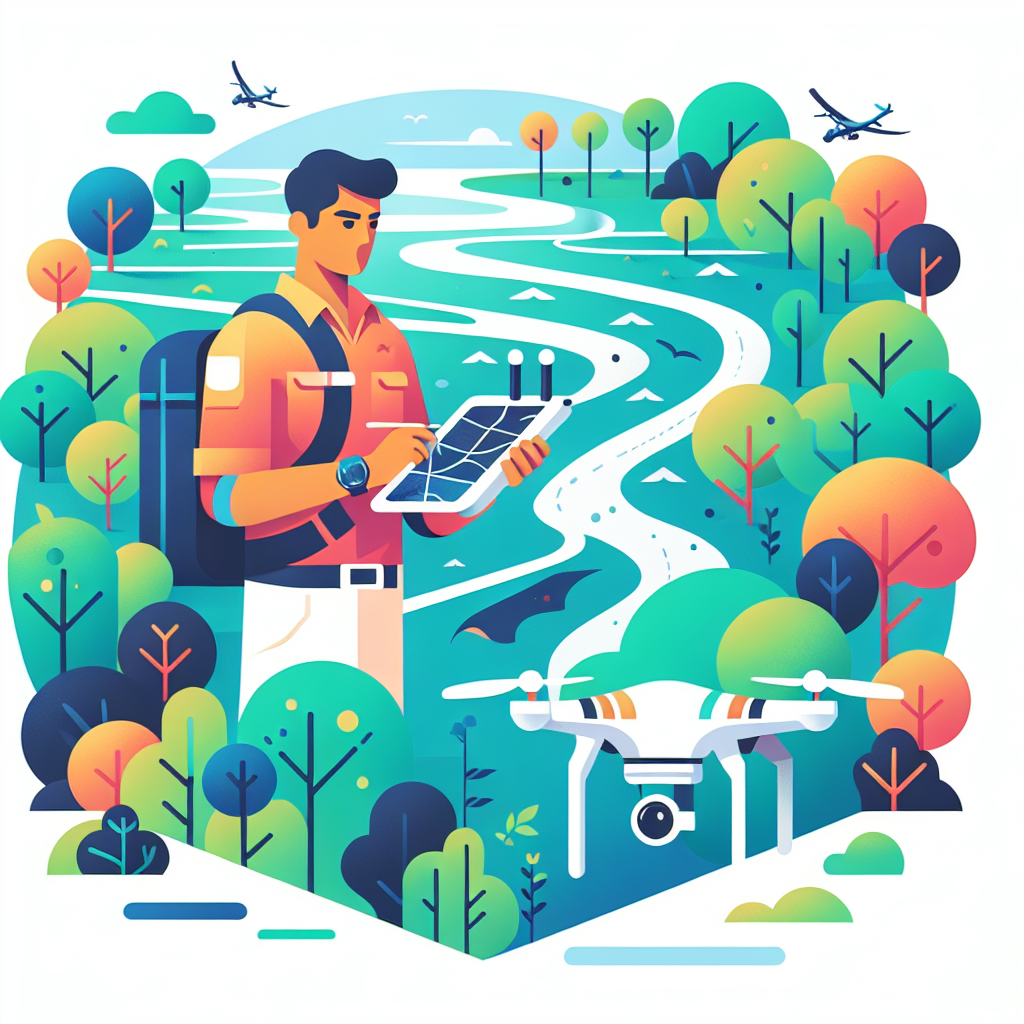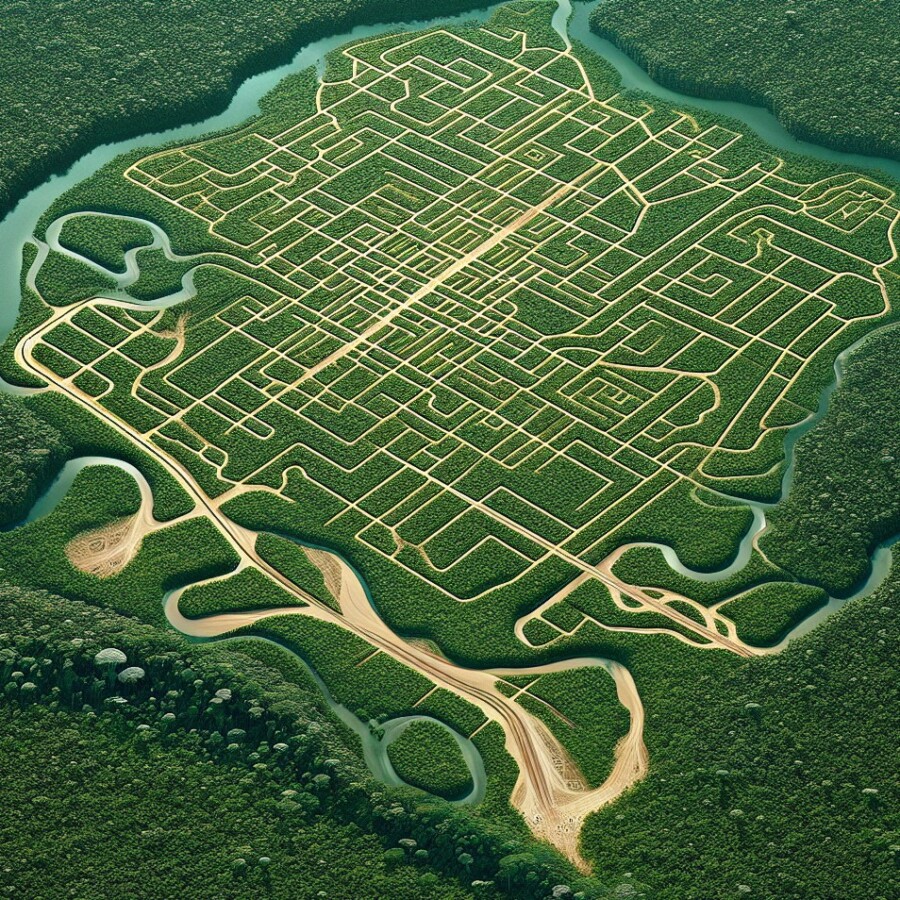Preserving mangrove forests, such as the vast Sundarbans, poses challenges due to the dense vegetation and presence of wild animals. Vishal Jaiswal, a drone pilot, mapped a portion of the Sundarbans to aid in conservation efforts. Mangroves worldwide are at risk due to factors like deforestation, pollution, and climate change, with over half of them facing collapse by 2050.
While some Indian mangroves, like the Sundarbans, are not classified as endangered, signs of stress from human activities and natural causes are evident. Dr. Sahadev Sharma highlights issues such as deforestation and erosion in the Sundarbans, exacerbated by factors like shrimp farming and development. The difficult terrain and presence of saltwater crocodiles and Bengal tigers make field research challenging for scientists.
To monitor the health of mangrove forests, scientists are turning to technology like drones and rSETs (rod surface elevation tables). These tools help measure factors like mangrove height in relation to sea level, crucial for understanding the impact of rising sea levels on the ecosystem. While these methods are more expensive, they offer greater precision and efficiency compared to traditional techniques.
Communities living in coastal regions that rely on mangroves for survival are recognizing the importance of preserving these ecosystems. Fishermen like Laxman Anna in Andhra Pradesh have seen improvements in their catches after efforts to restore mangroves. By planting saplings and working with NGOs and forest departments, communities are witnessing positive changes in their fishing livelihoods.
In conclusion, the preservation of mangrove forests is vital for biodiversity and the livelihoods of coastal communities. Through the use of technology and community efforts, there is hope for the sustainable conservation of these crucial ecosystems. Continued research and collaboration are essential to protect mangroves from the threats of climate change and human activities.
Original news source: Tigers and crocs make mangrove preservation tough work (BBC)
🎧 Listen:
Slow
Normal
Fast
📖 Vocabulary:
| 1 | conservation | The protection and preservation of natural resources and environments |
| 2 | deforestation | The removal of trees from an area, often leading to environmental damage |
| 3 | erosion | The gradual wearing away of land by natural forces such as wind or water |
| 4 | terrain | The physical features and characteristics of a particular area of land |
| 5 | ecosystem | A community of living organisms and their physical environment interacting as a system |
| 6 | precision | The quality of being exact and accurate |
| 7 | efficiency | The ability to accomplish a task with minimal waste of time and resources |
| 8 | biodiversity | The variety of different species of plants and animals in a particular habitat |
| 9 | saplings | Young trees that are planted to grow and develop |
| 10 | collaboration | Working together with others to achieve a common goal |
| 11 | sustainable | Capable of being maintained over the long term without harming the environment |
| 12 | crucial | Extremely important or necessary |
| 13 | threats | Potential dangers or risks that could cause harm |
| 14 | coastal | Related to or located near the sea or ocean |
| 15 | livelihoods | The means of securing the necessities of life, such as food and shelter, often through work or employment |
Group or Classroom Activities
Warm-up Activities:
– Headline Creation
Instructions: Ask students to work in pairs or small groups to create a catchy headline summarizing the main idea of the article about preserving mangrove forests. Encourage them to be creative and concise in their headline.
– Vocabulary Pictionary
Instructions: Provide a list of key vocabulary words from the article (e.g., mangrove, conservation, ecosystem, deforestation) and have students draw quick sketches representing each word. Their classmates need to guess the word based on the drawing.
– Opinion Spectrum
Instructions: Divide the class into two groups: one group representing scientists and environmentalists, and the other group representing developers and businesses. Assign each group a side to argue for or against the preservation of mangrove forests. Have students stand on a spectrum line based on how strongly they agree or disagree with the given statement.
– Pros and Cons
Instructions: Have students work individually or in pairs to list the pros and cons of using drones and rSETs for monitoring mangrove forests, as mentioned in the article. Encourage them to think critically and consider different aspects such as cost, efficiency, and accuracy.
– Think-Pair-Share
Instructions: Ask students to think about a personal experience or example related to environmental conservation efforts or the impact of climate change. Have them share their thoughts with a partner, and then select a few students to share with the whole class. Encourage discussions and reflections on the importance of protecting natural ecosystems like mangrove forests.
🤔 Comprehension Questions:
1. What challenges do dense vegetation and the presence of wild animals pose to the preservation of mangrove forests like the Sundarbans?
2. How did drone pilot Vishal Jaiswal contribute to conservation efforts in the Sundarbans?
3. What are some of the factors putting mangroves worldwide at risk according to the article?
4. Why does Dr. Sahadev Sharma mention deforestation and erosion as issues in the Sundarbans?
5. How do tools like drones and rSETs help scientists monitor the health of mangrove forests?
6. What positive changes have fishermen like Laxman Anna in Andhra Pradesh seen after efforts to restore mangroves?
7. Why is the preservation of mangrove forests considered vital for biodiversity and the livelihoods of coastal communities?
8. According to the article, what is essential for protecting mangroves from the threats of climate change and human activities?
Go to answers ⇩
🎧✍️ Listen and Fill in the Gaps:
Preserving mangrove forests, such as the vast Sundarbans, poses challenges due to the dense (1)______ and presence of wild animals. Vishal Jaiswal, a drone (2)______, mapped a (3)______ of the Sundarbans to aid in conservation efforts. Mangroves worldwide are at risk due to factors like deforestation, pollution, and (4)______ change, with over half of them facing collapse by 2050.
While some Indian mangroves, like the Sundarbans, are not classified as endangered, signs of stress from human activities and natural causes are evident. Dr. Sahadev Sharma highlights issues such as deforestation and (5)______ in the Sundarbans, exacerbated by factors like shrimp farming and development. The difficult terrain and presence of saltwater crocodiles and Bengal tigers make field research challenging for scientists.
To (6)______ the (7)______ of mangrove forests, scientists are turning to technology like drones and rSETs (rod surface elevation tables). These (8)______ help measure factors like mangrove height in relation to sea (9)______, crucial for understanding the impact of rising sea levels on the ecosystem. While these methods are more expensive, they offer (10)______ precision and efficiency compared to traditional techniques.
Communities living in coastal regions that rely on mangroves for survival are (11)______ the importance of preserving these ecosystems. Fishermen like Laxman Anna in Andhra Pradesh have seen improvements in their catches after efforts to (12)______ mangroves. By planting saplings and working with NGOs and forest departments, communities are witnessing positive changes in their fishing (13)______.
In conclusion, the preservation of mangrove forests is vital for biodiversity and the livelihoods of coastal communities. Through the use of technology and community (14)______, there is hope for the sustainable (15)______ of these crucial ecosystems. Continued research and collaboration are essential to protect mangroves from the threats of climate change and (16)______ activities.
Go to answers ⇩
💬 Discussion Questions:
Students can ask a partner these questions, or discuss them as a group.
1. What is the significance of mangrove forests for coastal communities?
2. How would you feel if you lived in a coastal region that heavily relied on mangroves for survival?
3. Do you think technological advancements like drones are crucial for monitoring and preserving mangrove forests? Why or why not?
4. How do you think climate change is impacting mangrove forests around the world?
5. Do you believe that communities should play a key role in the conservation of mangrove ecosystems? Why or why not?
6. What are some potential solutions to the challenges faced in preserving mangrove forests?
7. Why do you think some mangrove forests are more at risk than others?
8. How do you think the presence of wild animals like saltwater crocodiles and Bengal tigers affects conservation efforts in mangrove forests?
9. What are some ways in which mangrove forests benefit the environment beyond just coastal communities?
10. Do you think governments should play a stronger role in protecting mangrove forests? Why or why not?
11. How do you think the depletion of mangrove forests could impact global biodiversity?
12. What are some alternative livelihood options that could help reduce the pressure on mangrove ecosystems?
13. Why do you think some communities may be resistant to conservation efforts aimed at preserving mangrove forests?
14. How do you think traditional techniques for monitoring mangrove forests compare to newer technologies like drones?
15. Do you think the international community should do more to protect mangrove forests worldwide? Why or why not?
Individual Activities
📖💭 Vocabulary Meanings:
Match each word to its meaning.
Words:
1. conservation
2. deforestation
3. erosion
4. terrain
5. ecosystem
6. precision
7. efficiency
8. biodiversity
9. saplings
10. collaboration
11. sustainable
12. crucial
13. threats
14. coastal
15. livelihoods
Meanings:
(A) The variety of different species of plants and animals in a particular habitat
(B) The ability to accomplish a task with minimal waste of time and resources
(C) The removal of trees from an area, often leading to environmental damage
(D) The quality of being exact and accurate
(E) Young trees that are planted to grow and develop
(F) The protection and preservation of natural resources and environments
(G) The gradual wearing away of land by natural forces such as wind or water
(H) The physical features and characteristics of a particular area of land
(I) Capable of being maintained over the long term without harming the environment
(J) A community of living organisms and their physical environment interacting as a system
(K) Potential dangers or risks that could cause harm
(L) Working together with others to achieve a common goal
(M) The means of securing the necessities of life, such as food and shelter, often through work or employment
(N) Extremely important or necessary
(O) Related to or located near the sea or ocean
Go to answers ⇩
🔡 Multiple Choice Questions:
1. What technology did Vishal Jaiswal use to map a portion of the Sundarbans for conservation efforts?
(a) Drones
(b) Satellites
(c) Underwater cameras
(d) GPS trackers
2. What is one of the risks faced by mangrove forests worldwide mentioned in the article?
(a) Overpopulation
(b) Desertification
(c) Snowstorms
(d) Deforestation
3. What is a factor contributing to stress on Indian mangroves like the Sundarbans according to Dr. Sahadev Sharma?
(a) Excessive rainfall
(b) Lack of sunlight
(c) Deforestation and erosion
(d) Urbanization
4. What makes field research challenging for scientists studying the Sundarbans?
(a) Lack of funding
(b) Presence of saltwater crocodiles and Bengal tigers
(c) Easy accessibility
(d) Mild climate
5. What technology are scientists using to monitor the health of mangrove forests in the article?
(a) Drones and rSETs
(b) Binoculars
(c) Compasses
(d) Walkie-talkies
6. What do drones and rSETs help measure in mangrove forests?
(a) Bird populations
(b) Mangrove height in relation to sea level
(c) Soil pH levels
(d) Rainfall amounts
7. How have communities living in coastal regions benefited from efforts to restore mangroves?
(a) Decrease in water quality
(b) Increase in air pollution
(c) Improvements in fishing catches
(d) Loss of biodiversity
8. What is highlighted as essential for the sustainable conservation of mangrove forests in the article?
(a) Increased deforestation
(b) Indiscriminate development
(c) Climate change denial
(d) Continued research and collaboration
Go to answers ⇩
🕵️ True or False Questions:
1. Dr. Sahadev Sharma highlights issues such as deforestation and erosion in the Sundarbans caused by factors like shrimp farming and development.
2. Vishal Jaiswal, a drone pilot, mapped a portion of the Sundarbans to assist in conservation efforts.
3. Fishermen like Laxman Anna in Andhra Pradesh have observed declines in their catches despite efforts to restore mangroves.
4. Over half of mangroves worldwide are expected to thrive by 2050 due to factors like conservation efforts, reduced pollution, and climate change.
5. Discontinued research and collaboration are deemed essential to protect mangroves from the threats of climate change and human activities.
6. Communities living in coastal regions are ignoring the importance of preserving mangroves for their survival.
7. The presence of saltwater crocodiles and Bengal tigers in the Sundarbans makes field research challenging for scientists.
8. Scientists are utilizing technology like drones and rSETs to monitor the health of mangrove forests, measuring factors like mangrove height in relation to sea level.
Go to answers ⇩
📝 Write a Summary:
Write a summary of this news article in two sentences.
Check your writing now with the best free AI for English writing!
Writing Questions:
Answer the following questions. Write as much as you can for each answer.
Check your answers with our free English writing assistant!
1. How has technology, such as drones and rSETs, been utilized to monitor the health of mangrove forests like the Sundarbans?
2. What are some of the challenges faced by scientists conducting field research in the Sundarbans, and how do these challenges impact conservation efforts?
3. How have communities living in coastal regions, such as fishermen in Andhra Pradesh, been involved in efforts to preserve mangrove ecosystems?
4. What are some of the factors contributing to the risk faced by mangroves worldwide, and what are the potential consequences of over half of them collapsing by 2050?
5. Why is the preservation of mangrove forests considered vital for biodiversity and the livelihoods of coastal communities, and what role does continued research and collaboration play in their conservation?
✅ Answers
🤔✅ Comprehension Question Answers:
1. What challenges do dense vegetation and the presence of wild animals pose to the preservation of mangrove forests like the Sundarbans?
– The dense vegetation and presence of wild animals in mangrove forests like the Sundarbans pose challenges for conservation efforts due to the difficult terrain and risks associated with field research.
2. How did drone pilot Vishal Jaiswal contribute to conservation efforts in the Sundarbans?
– Vishal Jaiswal, a drone pilot, mapped a portion of the Sundarbans using drones to aid in conservation efforts by providing valuable data for monitoring and understanding the ecosystem.
3. What are some of the factors putting mangroves worldwide at risk according to the article?
– Factors putting mangroves worldwide at risk include deforestation, pollution, and climate change, with over half of mangroves facing collapse by 2050.
4. Why does Dr. Sahadev Sharma mention deforestation and erosion as issues in the Sundarbans?
– Dr. Sahadev Sharma highlights deforestation and erosion in the Sundarbans as issues exacerbated by factors like shrimp farming and development, which are impacting the health of the mangrove forests.
5. How do tools like drones and rSETs help scientists monitor the health of mangrove forests?
– Tools like drones and rSETs help scientists measure factors like mangrove height in relation to sea level, providing crucial data for understanding the impact of rising sea levels on the ecosystem with greater precision and efficiency.
6. What positive changes have fishermen like Laxman Anna in Andhra Pradesh seen after efforts to restore mangroves?
– Fishermen like Laxman Anna in Andhra Pradesh have seen improvements in their catches after efforts to restore mangroves, indicating positive changes in their fishing livelihoods.
7. Why is the preservation of mangrove forests considered vital for biodiversity and the livelihoods of coastal communities?
– The preservation of mangrove forests is vital for biodiversity and the livelihoods of coastal communities as they provide habitats for diverse species, protect coastlines, and support the livelihoods of communities dependent on them for resources.
8. According to the article, what is essential for protecting mangroves from the threats of climate change and human activities?
– Continued research and collaboration are essential for protecting mangroves from the threats of climate change and human activities, ensuring sustainable conservation efforts for these crucial ecosystems.
Go back to questions ⇧
🎧✍️✅ Listen and Fill in the Gaps Answers:
(1) vegetation
(2) pilot
(3) portion
(4) climate
(5) erosion
(6) monitor
(7) health
(8) tools
(9) level
(10) greater
(11) recognizing
(12) restore
(13) livelihoods
(14) efforts
(15) conservation
(16) human
Go back to questions ⇧
📖💭✅ Vocabulary Meanings Answers:
1. conservation
Answer: (F) The protection and preservation of natural resources and environments
2. deforestation
Answer: (C) The removal of trees from an area, often leading to environmental damage
3. erosion
Answer: (G) The gradual wearing away of land by natural forces such as wind or water
4. terrain
Answer: (H) The physical features and characteristics of a particular area of land
5. ecosystem
Answer: (J) A community of living organisms and their physical environment interacting as a system
6. precision
Answer: (D) The quality of being exact and accurate
7. efficiency
Answer: (B) The ability to accomplish a task with minimal waste of time and resources
8. biodiversity
Answer: (A) The variety of different species of plants and animals in a particular habitat
9. saplings
Answer: (E) Young trees that are planted to grow and develop
10. collaboration
Answer: (L) Working together with others to achieve a common goal
11. sustainable
Answer: (I) Capable of being maintained over the long term without harming the environment
12. crucial
Answer: (N) Extremely important or necessary
13. threats
Answer: (K) Potential dangers or risks that could cause harm
14. coastal
Answer: (O) Related to or located near the sea or ocean
15. livelihoods
Answer: (M) The means of securing the necessities of life, such as food and shelter, often through work or employment
Go back to questions ⇧
🔡✅ Multiple Choice Answers:
1. What technology did Vishal Jaiswal use to map a portion of the Sundarbans for conservation efforts?
Answer: (a) Drones
2. What is one of the risks faced by mangrove forests worldwide mentioned in the article?
Answer: (d) Deforestation
3. What is a factor contributing to stress on Indian mangroves like the Sundarbans according to Dr. Sahadev Sharma?
Answer: (c) Deforestation and erosion
4. What makes field research challenging for scientists studying the Sundarbans?
Answer: (b) Presence of saltwater crocodiles and Bengal tigers
5. What technology are scientists using to monitor the health of mangrove forests in the article?
Answer: (a) Drones and rSETs
6. What do drones and rSETs help measure in mangrove forests?
Answer: (b) Mangrove height in relation to sea level
7. How have communities living in coastal regions benefited from efforts to restore mangroves?
Answer: (c) Improvements in fishing catches
8. What is highlighted as essential for the sustainable conservation of mangrove forests in the article?
Answer: (d) Continued research and collaboration
Go back to questions ⇧
🕵️✅ True or False Answers:
1. Dr. Sahadev Sharma highlights issues such as deforestation and erosion in the Sundarbans caused by factors like shrimp farming and development. (Answer: True)
2. Vishal Jaiswal, a drone pilot, mapped a portion of the Sundarbans to assist in conservation efforts. (Answer: True)
3. Fishermen like Laxman Anna in Andhra Pradesh have observed declines in their catches despite efforts to restore mangroves. (Answer: False)
4. Over half of mangroves worldwide are expected to thrive by 2050 due to factors like conservation efforts, reduced pollution, and climate change. (Answer: False)
5. Discontinued research and collaboration are deemed essential to protect mangroves from the threats of climate change and human activities. (Answer: False)
6. Communities living in coastal regions are ignoring the importance of preserving mangroves for their survival. (Answer: False)
7. The presence of saltwater crocodiles and Bengal tigers in the Sundarbans makes field research challenging for scientists. (Answer: True)
8. Scientists are utilizing technology like drones and rSETs to monitor the health of mangrove forests, measuring factors like mangrove height in relation to sea level. (Answer: True)
Go back to questions ⇧













